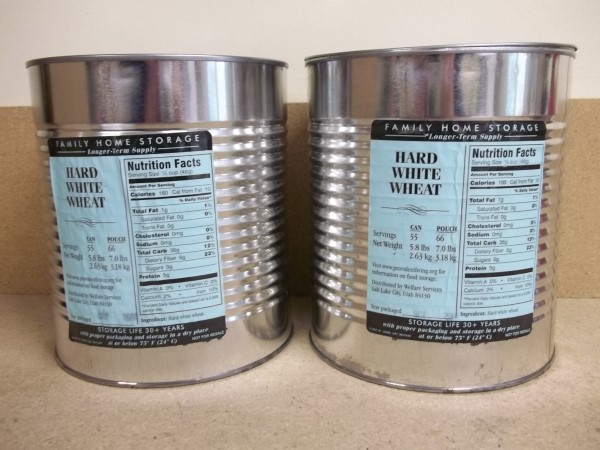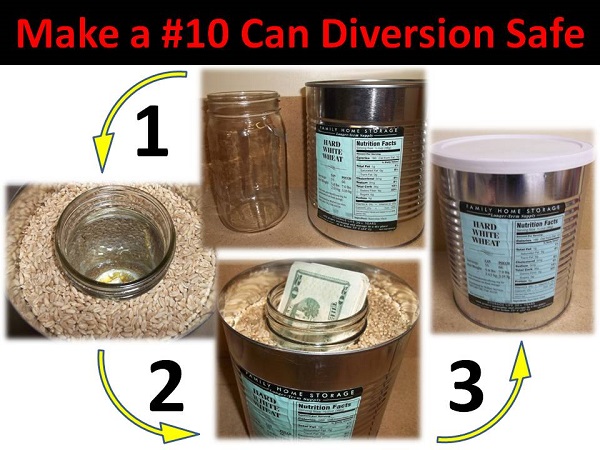I had fun making the Diversion Safe Using a Vegetable Can the other week and wondered if I could make the idea even more useful using a typical #10 coffee can. I choose to use a can of white wheat because I figured that almost nobody would choose to mess with a can of wheat. 😉
After placing a mason jar inside an empty #10 can to see if it would even fit closely, to my surprise, it did and so I made the attempt. Overall, I’d say the idea worked out better than I thought it would.
Supplies needed:
- #10 can with dry ingredients (I used white wheat)
- wide mouth mason jar, lid, ring
- strong glue (I used gorilla glue; you might be able to use expanding foam too)
- something to cushion contents inside mason jar (e.g., towle, batting, cotton balls, etc)
- something to strengthen lid to flatten it out (I used metal straps but probably need something better)
- various items to weight things down while they glue (e.g., dumbbells, other cans of wheat, etc)
Here’s what I did:
- Remove the can lid using a SAFETY can opener so that the lid will sit on the can once removed. If you use a normal can opener this project won’t work!
- Flip the coffee can lid upside down. Using a strong glue (I used Gorilla glue for everything) glue the mason jar lid and ring to it. Be sure to get it as centered as possible otherwise the lid won’t seat to the can properly when screwed down.
- Glue the mason jar inside the coffee can. Again, take care to get this centered and check it after several minutes as it’s possible the mason jar can slide early on and no longer be centered.
- Once you’re satisfied everything is centered properly, weight the lid and mason jar down and let sit overnight. You’ll notice I used two mason jars to speed things up but you could make this work with only a single mason jar, if you like.
- Place a lid over the mason jar and fill the coffee can with wheat. I used several cups. Be sure to leave enough room at the top to screw on/off the mason jar lid.
- After the lid and jar dried I noticed that the coffee can lid warped quite a bit when screwed down. You can see it in this photo on the sides. It’s quite noticeable here, more so because I didn’t screw down the lid completely (specifically for this photo) so that the warping was more obviously exaggerated. Even when screwed down completely it’s fairly obvious something is wrong with this supposedly unopened can of wheat.
- To attempt to fix this, I marked the two spots on the can lid where the warping was most significant as well as the two spots where it was the least warped. This turned out to be more or less on opposite sides of the lid.
- I then cut pieces of metal strapping to act as supports in an effort to counteract the warping.
- After cutting off angles on each of the straps so that the lid would fit when screwed down, I weighted down the middle of the lid with a dumbbell to get the lid to flatten out completely and then glued the straps with copious amounts of Gorilla glue. I waited overnight for it to dry.
So, which one is the safe? Go on take a look…

If you guessed it’s the one on the right, you’re correct. If you look closely you should be able to tell that the lid still warps a bit but it’s not nearly as noticeable as it was. I really thought the glued-down straps would fix the problem–and it helped a lot–but the lid still isn’t quite perfectly flat. Sadly, I can’t think of a better way to fix the warping and still allow the lid to unscrew.
Until I figure it out I just placed a plastic lid over on top and everything looks great! Now place a bunch of plastic lids on other unopened cans and it won’t look out of place. 😉
Notes:
- The lid, like the previous DIY safe using a vegetable can, is a bear to get off. I had to use the rubber gloves I used last time to get it off and even more effort. Good luck if you don’t have something like that to get the lid off! Don’t say I didn’t warn you.
- Adding wheat to the jar makes a big difference in believing this could be nothing more than a can of wheat. Though a bit lighter than a full can of wheat it’s not immediately noticeable, plus it sounds like a can of wheat.
- You’ll still want to cushion the items inside the mason jar with something to keep them from rattling around. Perhaps a rag, the batting that goes in a couch, or cotton balls may all work. Whatever you use test it by shaking the can around once filled your goodies.
- Bury the can in the back of your pantry and it would take a seriously determined crook to find your stash.
- In steps 2-4, instead of gluing the lid and mason jar separately, to ensure you get it centered properly you could glue the lid first, wait for it to dry completely, then screw the mason jar onto the lid and use the now centered lid to ensure the mason jar gets centered inside the coffee can when you glue it. If I did this project again that’s what I would do.
Granted, you could just bury a mason jar or a Ziploc bag inside a #10 can filled with wheat and NOT bother with gluing everything but where’s the fun in that? Besides, you wouldn’t be able to as quickly access your stuff if you did that.
Give it a try and let me know what you think.










Leave a Reply